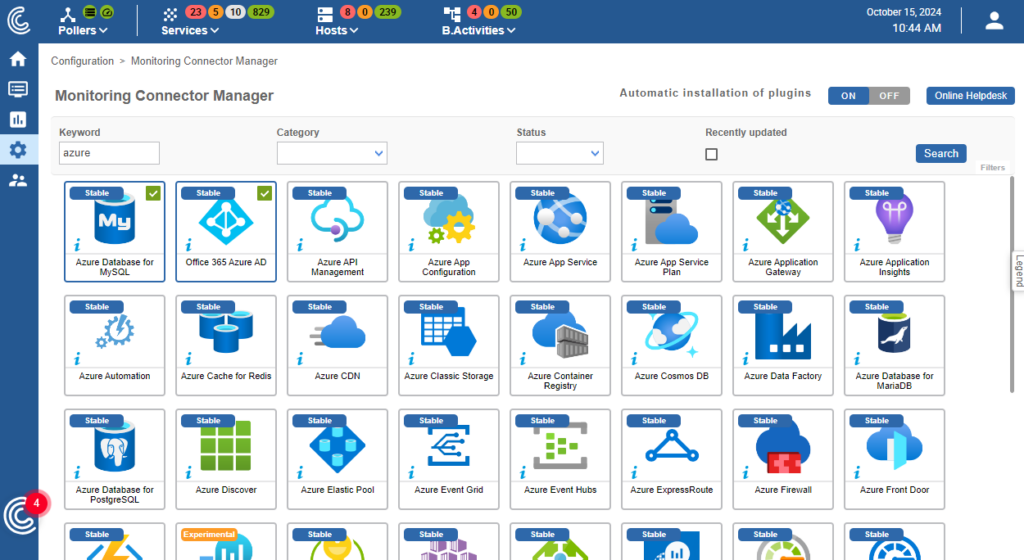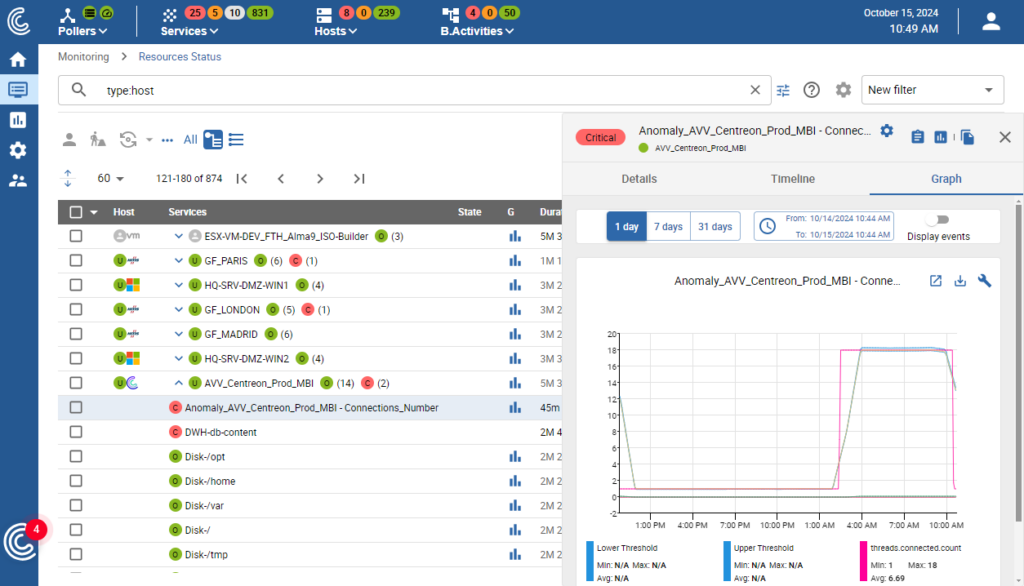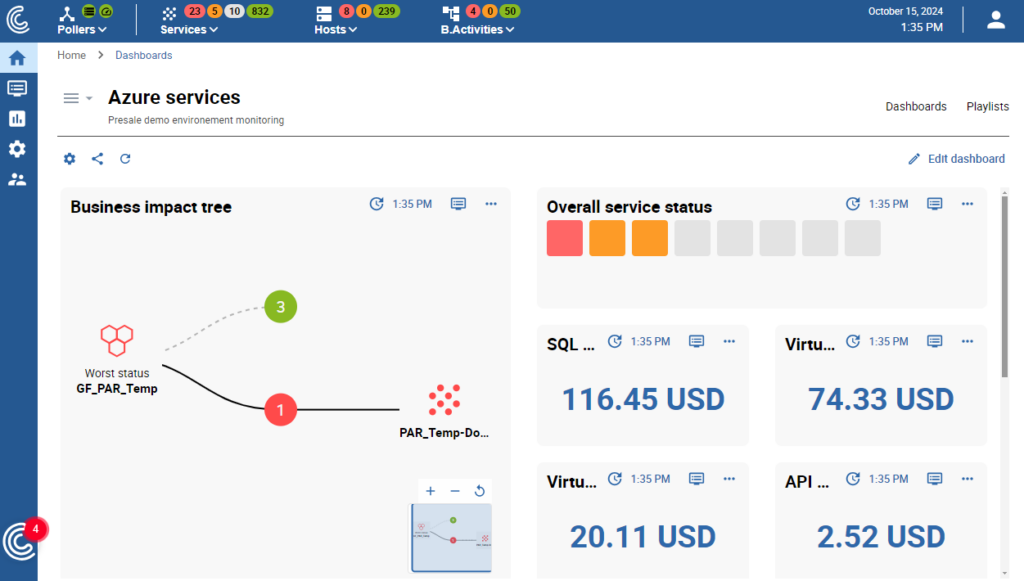Microsoft Azure Monitoring
Microsoft Azure Monitoring with Centreon: Achieve End-to-End Cloud Visibility
OVERVIEW
Overview of Microsoft Azure Monitoring
Understanding Microsoft Azure and Its Importance
Microsoft Azure is one of the most widely adopted public cloud platforms, often categorized as a hyperscaler due to its vast range of services. As a provider of both Infrastructure-as-a-Service (IaaS) and Platform-as-a-Service (PaaS), Azure is utilized by businesses of all sizes to manage compute, database, storage, content delivery, AI, and other services. It simplifies platform management, enabling organizations to innovate efficiently on a trusted cloud platform.
However, managing a broad array of complex services and resources can be challenging. Maintaining visibility across all layers of the Azure infrastructure is essential for diagnosing performance issues and ensuring that cloud resources are being used effectively. Given the critical nature of applications running on Azure, monitoring both system-level metrics and the performance metrics of applications is crucial.
The Need for Comprehensive Monitoring in Azure
Microsoft Azure provides built-in tools for monitoring, but integrating these into a broader strategy is important for end-to-end visibility. Several elements of the Azure Well-Architected Framework highlight the need for robust monitoring:
- Operational Excellence (OE:07): Guidance on designing effective monitoring systems.
- Performance Efficiency (PE:11): Recommendations for managing live performance issues.
- Security (SE.10): Best practices for monitoring and threat detection.
The Azure Shared Responsibility Model is a key concept in Azure monitoring. While Microsoft manages the security of the cloud itself, customers are responsible for managing their own data and services within Azure. This underscores the need for Azure-independent monitoring tools that can integrate with broader IT systems, especially during “lift and shift” migrations and when managing hybrid or multi-cloud environments.
Effective monitoring also plays a role in controlling cloud service costs. The flexibility of Azure’s pay-as-you-go pricing model can lead to unexpectedly high expenses if resources aren’t managed carefully. Monitoring helps organizations maintain predictable costs and avoid vendor lock-in, offering the freedom to adapt their cloud strategy as needed.
HOW WE HELP
How Centreon Enhances Microsoft Azure Monitoring
Simplified Integration with Azure Services
Centreon’s solution for Microsoft Azure monitoring offers a streamlined setup through out-of-the-box connectors, making it easy to integrate with Azure’s API. This enables organizations to:
- Discover Azure Cloud Infrastructure: Automatically identify all Azure resources, including virtual machines, databases, and containers.
- Establish Monitoring Policies: Apply standardized monitoring practices across Azure services to ensure consistent oversight.
- Visualize Data Richly: Use custom dashboards and data visualizations to interpret Azure performance metrics effectively.
- Trigger Alerts and Automate Actions: Set up alerts that initiate automated responses to maintain service continuity.
Analyze Historical Data: Track long-term performance trends and resource usage for better strategic planning.
Automated Azure Monitoring with Centreon
Centreon supports the monitoring of over 25 Azure services, such as Azure Virtual Machines (VMs), Azure SQL Database, Azure Functions, Azure API Management, and Azure Kubernetes Service (AKS). The Azure connectors make it simple to capture and analyze metrics, such as CPU usage, memory consumption, connection counts, and network traffic.
For services that aren’t directly supported by a specific connector, the generic Azure Monitor and Azure InsightMetrics connectors enable data collection across all other Azure services. Additionally, Centreon can monitor Azure Log Analytics, detecting abnormal occurrences through KQL queries and monitoring the number of matched items.tions or notifications, ensuring that issues are addressed quickly.

Cost Monitoring and Optimization
One of the significant advantages of using Centreon for Azure monitoring is the ability to track and optimize costs. With the Azure Management Costs connector, users can gain visibility into estimated charges and identify trends that could lead to cost overruns. This helps ensure that billing tags are properly assigned, allowing organizations to manage their budgets effectively and avoid unpleasant surprises.

Multi-source Monitoring Capabilities
Centreon’s approach to Azure monitoring is flexible, adapting to different needs depending on the criticality of workloads and network access policies. This can include:
Agent-based Monitoring: For greater granularity, deploy agents directly on Azure Virtual Machines to collect detailed metrics such as memory utilization and disk usage.s, providing detailed metrics on the counts of active and failed connections.
Using Azure API Connectors: Monitor metrics directly through Azure’s API using the Centreon connectors.
Agentless Monitoring: Capture data through application APIs or SSH for a broader view without deploying agents.
Custom Dashboards and Visualizations
Once Azure metrics are integrated into the Centreon platform, users can leverage powerful visualization tools:
- Interactive Dashboards: Track the status of Azure services, from VMs to databases, using real-time dashboards.
- Service Weather Maps: Visualize the health of critical services in operation centers, offering a comprehensive view of cloud status.
Business Activity Diagrams: Map dependencies between systems, databases, and APIs to understand the impact of issues on business processes and cross-cloud architectures.

Streamlined Alerts and Incident Management
Centreon’s robust alerting capabilities allow users to stay on top of any issues within their Azure environment:
- Custom Notification Settings: Configure alerts to be sent via email or integrate with incident management tools like PagerDuty for immediate response.
Automated Responses: Set triggers to initiate specific actions when metrics fall outside of predefined thresholds, helping to keep services running smoothly with minimal manual intervention.
CENTREON BENEFITS
Centreon Benefits for Microsoft Azure Monitoring

Cloud & “Not Cloud”
Centreon captures the entire infrastructure of IT workflows, from applications to middleware to equipment, whether cloud or “not cloud.” Such comprehensive visibility ensures complete control of digital performance.

Collaborative Views
Sharing of digital performance indicators with all stakeholders in the organization puts business context into IT monitoring for collaborative decision-making.

Extensive Integrations
By easily integrating with all IT Operations tools, Centreon streamlines all production processes: ITSM, incident management, Industrialization flows such as Infrastructure as Code, consolidation of indicators.
More from Centreon
Ready to see how Centreon can transform your business?
Keep informed on our latest news


